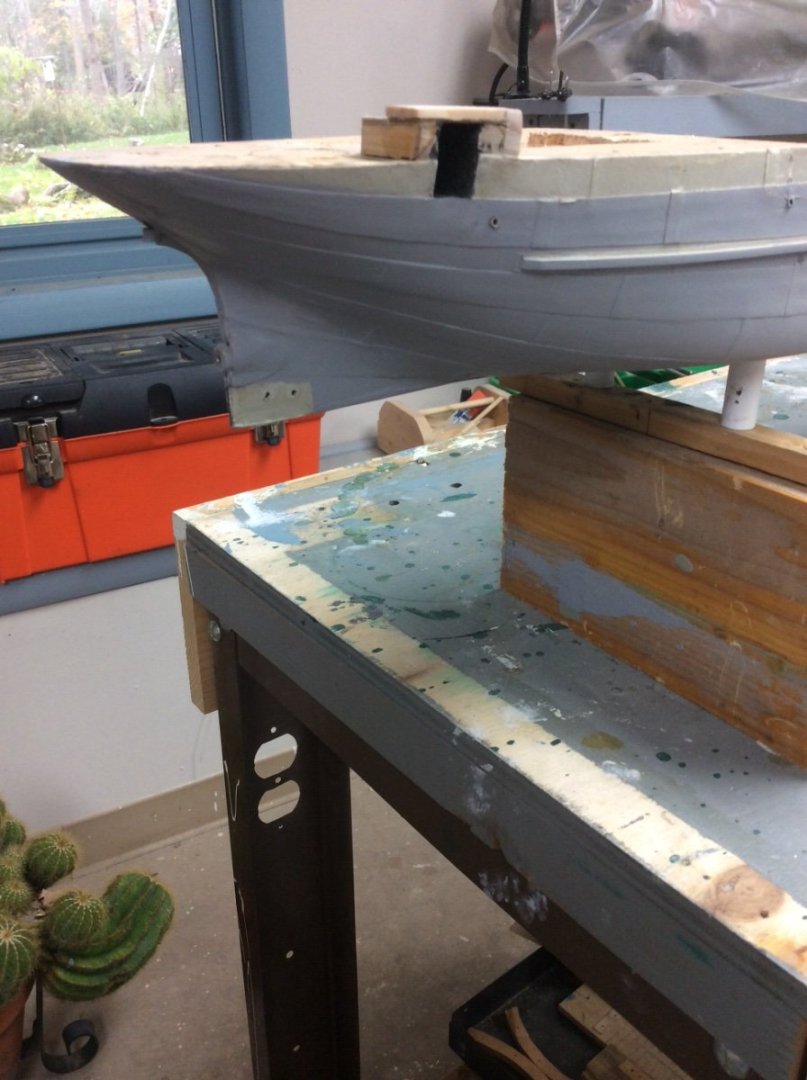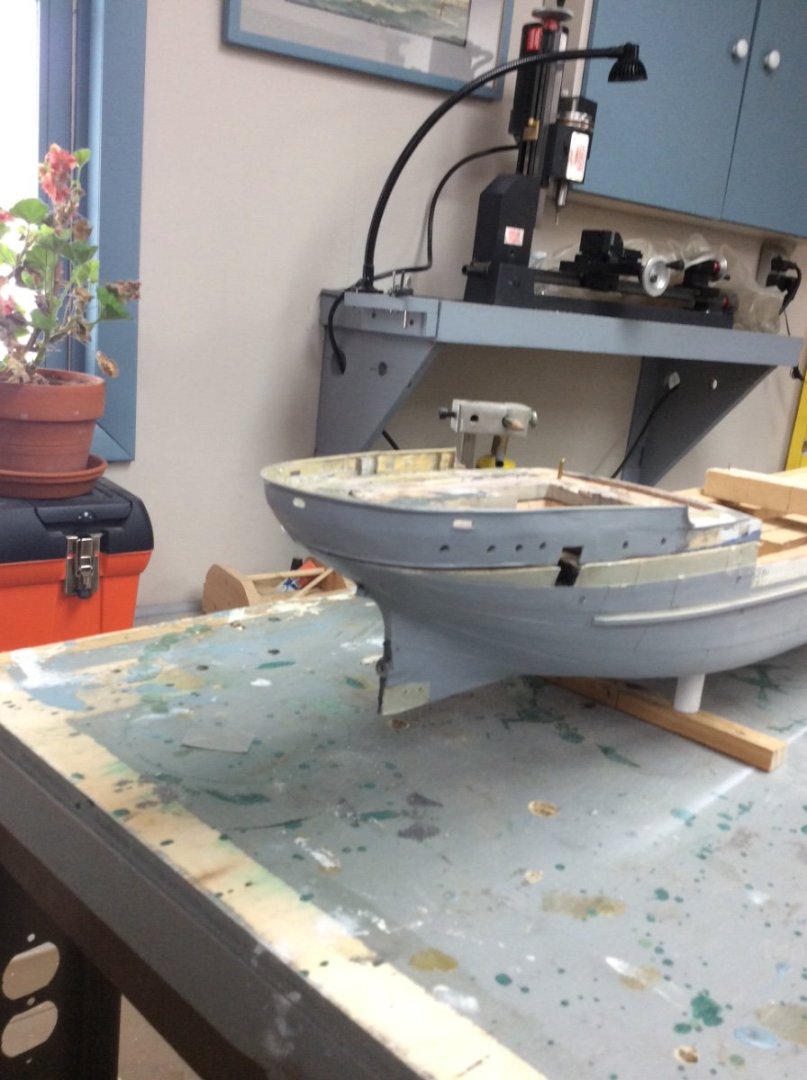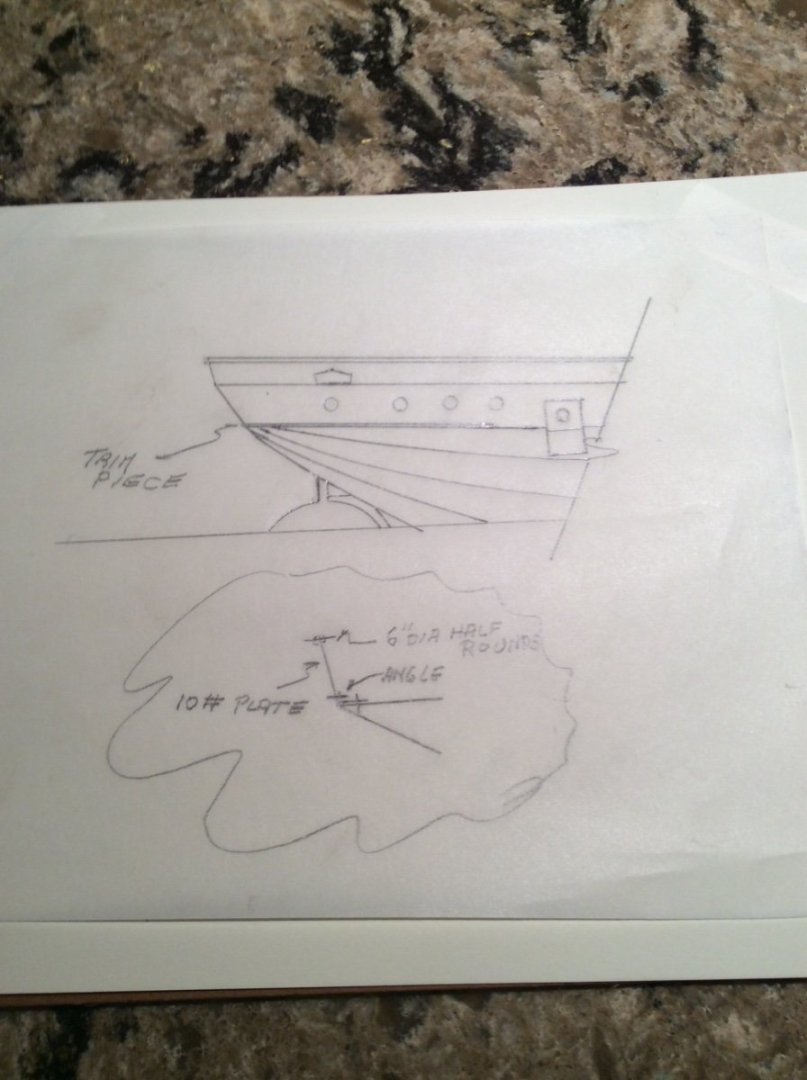
Roger Pellett
-
Posts
4,519 -
Joined
-
Last visited
Content Type
Profiles
Forums
Gallery
Events
Posts posted by Roger Pellett
-
-
Gunstock makers “whisker” the carved stock before applying a finish. This involves nothing more than wiping down with a wet cloth and letting the stock dry. The raised grain is then sanded off with fine sandpaper. The cycle is repeated until whiskers no longer appear. The same principle could be applied with water based paints on a ship model hull.
Roger
- Bob Cleek, East Ender, Canute and 1 other
-
 4
4
-
Gregory,
First, major typo! San Juan is believed to have been built about 1570.
Second, None whatsoever! However, as I am unaware of any contemporary evidence of the deck arrangement of a small c1600 three masted English Merchant Ship following known practice for another North AtLantic built vessel of the same era makes sense to me. This also gets it out of the way from the an hatch
Allan, Does recent research classify Mayflower as a fluyt? I always thought that she was English built.
Roger
-
Water raises the grain of wood. In practical terms, this means that a sanded surface gets a rough texture. This does not mean that you cannot use water soluble paints. Many acrylic paints are water soluble and are used to paint wooden models. If the paint raises the grain light sanding followed by another coat will be required. Or, you can first seal the wood with primer that does not contain water.
Roger
- mtaylor, East Ender and Canute
-
 3
3
-
-
-
The last model that I rigged was my 1:32 scale scratch built Longboat. I rigged it with linen “ hard twisted Cuttyhunk” line bought many years ago from Model Shipways. I first tried dying it with cold water fabric dye. I (thought) that I carefully followed Rob Napier’s excellent directions in his book about restoring a historic Dutch East Indiaman Model. He used Cuttyhunk linen line too. After drying the dyed line all of the dye wiped off.
Frustrated, I grabbed a bottle of Feibig leather dye. It worked perfectly. I believe that this is similar to the spirit based dyes that you are asking about.
Roger
- mtaylor and thibaultron
-
 2
2
-
Beautiful! It looks like Bluejacket furnished some quality mahogany for planking.
-
I’m not sure what special properties Model Shipways paints have that would make them particularly good for models. Paints have three principal ingredients; The pigment, the resin, and the vehicle. Paints may also have small additives to control selected properties such as surface tension, gloss etc.
The pigment is the color: generally a ground mineral powder. The more finely ground the powder, the better the paint.
Pigments are suspended in the resin. The resin is the liquid that undergoes a chemical reaction that causes the paint to harden around the suspended pigment. There are two common resins; alkyd, often called oil or enamel, and acrylic. There are other specialty paints that use other resins- Epoxy, Urethane, etc, that are not commonly used to paint models.
The vehicle, thins the uncured paint to allow it to be brushed or sprayed. It usually does not take part in the chemical reaction of the resin as it quickly evaporates. When paint is tacky, the vehicle has evaporated and the resin is curing. Different resins are thinned with different compatible vehicles.
Paint is therefore not that complicated, marketing programs notwithstanding. You want to buy a high quality paint with finely ground pigments that uses a resin that you are comfortable with. Oil based paints are smelly and slow curing but I find them easier to apply with a brush. Acrylics have less oder and cure faster.
Roger
- Belco, mtaylor, Ryland Craze and 6 others
-
 9
9
-
I believe that the stern plating is wrong. The upper strakes of plating normally do not wrap around to the sternpost. Instead they twist up to end at the counter. The ends of this plating are often covered by a decorative moulding that wraps horizontally around the counter. Plating around the fantail stern is as shown on your model. The stern lines also appear to be overly full. Pictures of usual plating arrangement posted below.



- Force9, Hubac's Historian, hof00 and 3 others
-
 6
6
-
John, I’ve been following your resurrection and outstanding completion of this kit with interest. You’re doing a great job.
As I read your posts, something about this model looked familiar so I looked Corasro II up on the Internet and discovered that although she is a sail training vessel for the Italian Navy, she was designed in the early 1950’s by Sparkman and Stevens, the renown New York Naval City yacht design firm.
Corasro resembles an older Sparkman and Stevens design, the iconic 1930’s era yawl Bolero. Bolero’s design, very long history, and 2001 restoration is beautifully recounted in the book “In a Class by Herself” by yachting historian John Rousmaniere. This is a well written, large format book full of color and black and white pictures of the boat. There is even a quote about someone forgetting to put drain holes in the Dorade vent boxes. The book was originally published by Mystic Seaport. It would be a great resource for anyone building a model of one of these boats.
Roger
-
Beautiful, furniture quality work! Just don’t forget to remove Winchelsea when you flip it over to use the lathe.😆
- mtaylor and Ryland Craze
-
 1
1
-
 1
1
-
The last model that I painted was a scratch built 1:32 scale rigged Longboat. I needed three major colors; Dark Brown for the outside of the hull, a dark red, and a color called “drab” I also needed an off white for below the waterline. I decided to paint the model with acrylic paints that I mixed myself.
I started with quality acrylic colors, sold in tubes at a local craft store. A large cheap tube bought from Walmart had particles of pigment so coarsely ground to be unusable. I squeezed a blob of each color needed onto a piece of glass and mixed them with a palette knife, adjusting the shade until it looked right. I spooned the mixed color into an airbrush jar and added some acrylic Matt Medium. I thinned the mix with ordinary tap water. I have a single action Badger Airbrush that sprayed the paint without a problem. Given all of the problems with commercially mixed colors posted above, this approach worked well for me.
The model that I am building now has large areas of soldered brass. It will be painted with Floquil paints.
Roger
- Canute, thibaultron, mtaylor and 1 other
-
 4
4
-
The Steam plants in the Iowa Class Battleships are similar to that in the United States. Several of these were brought out of mothballs in the 1980’s as part of the Regan era navy buildup. The cost to return their power plants to operating condition was major. The condition of United States’ power plant today is probably much worse and costs to restore it would be huge. It is also possible that some repair material and replacement equipment is unavailable. As the ultimate in ocean liner design she was a beautiful ship, but her days are long past.
Roger
-
United States was built with a healthy subsidy from the US Government, that required her to be fitted with a power plant to propel her at speeds higher than required for a normal TransAtlantic passenger liner. Her top speed was a classified military secret that I don’t believe has ever been revealed. State of the art for a high speed marine propulsion plant at the time of her launch was high pressure (600-900 psi) steam turning steam turbines.
State of the art marine engineering for new cruise ships is “all electric;”. Large Diesel engines generating electricity. Electricity is then dispatched to operate electric propulsion motors and to satisfy the huge hotel loads.
Even if United States could be cleaned up, her propulsion plant would be uneconomical to operate and probability expensive to replace. This assumes that a crew could be found that would be qualified to operate it.
Roger
-
A trick to protect already soldered joints from heat of nearby soldering is to use a Heat Sink. This can be anything that will absorb heat without sticking to melted solder. Aluminum is a good choice as it has excellent thermal conductivity and it will not fuse to ordinary solders. Stainless steel on the other hand is a poor conductor of heat.
I have been experimenting with another approach; using the latent heat of boiling water. Although this may sound “high tech” it is nothing more than covering the area to be protected with a small piece of water saturated paper towel. Heat from nearby soldering transferred to the wet paper heats the water which cannot get hotter than 212F until all of the water has boiled off. In some cases, such as rungs of a ladder, the wet paper be twisted up and inserted. This is easier than using a solid piece of metal.
Roger
-
If this were the original 1900 era Germania the display stand might look out of place, but this is the 21st Century Germania II. I, therefore, think that the modernistic stand looks great.
Roger
- FriedClams, mbp521, mtaylor and 3 others
-
 6
6
-
Some of the specialized tools that we use are still made here in the USA. Byrnes and Sherline come to mind. The last pin vice set that I bought (Moody) was made in the USA.
Roger
- thibaultron, rshousha, mtaylor and 1 other
-
 4
4
-
I personally prefer buying tools made in the USA where possible but lots of tools sold by major name brands unfortunately are not made here. I rather suspect that my Black & Decker Drill was made in China. A cynical marketing ploy seems to involve taking over highly regarded companies and then outsourcing manufacture to low wage countries. The only thing that survives is the name.
Note to all: I am NOT suggesting that Badger is involved in this sort of practice.
Roger
-
Like Baker, I too have an extensive library of maritime history books. I began buying books by Howard Chapelle in my 20’s and have continued ever since. In 2018, I joined the ranks of authors the first (and last)book that I wrote was published by an academic press. In several ways, books are like ship model kits. Many model builders never have enough of them and their value is not in paper and cardboard (or plywood and sticks) but in the work that the author spent accumulating and sharing the knowledge that they contain. These books are specialized and in most cases neither the authors or publishers are getting rich from them. In my case I enjoyed my 15 minutes of fame twice when my book was selected for two awards. Financially 4-1/2 years after publication the payment to the person hired to index the book has exceeded the royalties paid or owed to me. This is not a complaint, I don’t need the money and take great pleasure knowing that my research on a unique Great Lakes ship type will be available to scholars, model builders, etc long after I am gone.
Over the years, I have bought my share of “how to” ship modeling books but have disposed of most of them as I find their lasting value and to be limited. I did buy the recent book by Rob Napier published by Seawatch and am eagerly looking forward to reading it. At the other end of the book spectrum I really like published reports of maritime Archeology research of which the Mary Rose Book reviewed by Baker and included in my library, is an outstanding example. As these are even more specialized than run of the mill maritime history books, by necessity, they are more expensive.
if Ferrus Marcus is interested in building a model of a Spanish Galleon I would recommend the “Underwater Archeology of Red Bay” published by Parks Canada and distributed in the USA by Casemate Books. This book describes excavation of an actual Spanish vessel of the mid-late 1500’s. There is enough information within, including separate drawings to build a model incorporating all known historically accurate information.
Roger
-
It might also be because of natural oils IN the wood. For example, Teak has natural oils that can interfere with some glues. I’m not suggesting that the kit manufacturer supplied Teak. Rather it is probably some unfamiliar tropical hardwood and not real walnut.
Roger
-
-
-
This looks like an interesting project, Bill. Two half hulls are the wat to go.
Roger
- Tony Hunt, Bill Hudson and mtaylor
-
 3
3
-



Caroline N by mbp521 - Scale 1:64 - Mississippi River Towboat
in - Build logs for subjects built 1901 - Present Day
Posted
The rivers are best thought of as an integrated system. In addition to the Mississippi there is the Ohio, Missouri, Illinois, Tennessee, Monongahela, Allegheny, Cumberland, Kanawah, Arkansas, The Ten Tombigbee waterway, and countless navigable tributaries that I have failed to mention. This makes it possible for individual barge cargos to be sent incredible distances to a wide variety of ports. With the exception of the Mississippi below Cairo, Illinois water level is controlled by a series of locks and dams built, maintained, and operated by the US Army Corps of Engineers. I believe that minimum water level is 9ft. Historically, the US Government has not charged tolls or users fees to use this waterway system but proposals to assess them surface from time to time.
The Geography of the rivers effects the tows and the boat’s that push them. In most cases the size of the tows is dictated by the size of the lock chambers although it is possible to beak tows apart when going through the locks. On the other hand, the locks and dams serve to control the rivers’ currents. The Lower Mississippi (from Cairo South) is a different story as there are no locks to navigate and without dams controlling water levels the current is faster. This allows larger tows but requires larger, higher horsepower boats to push them
Roger